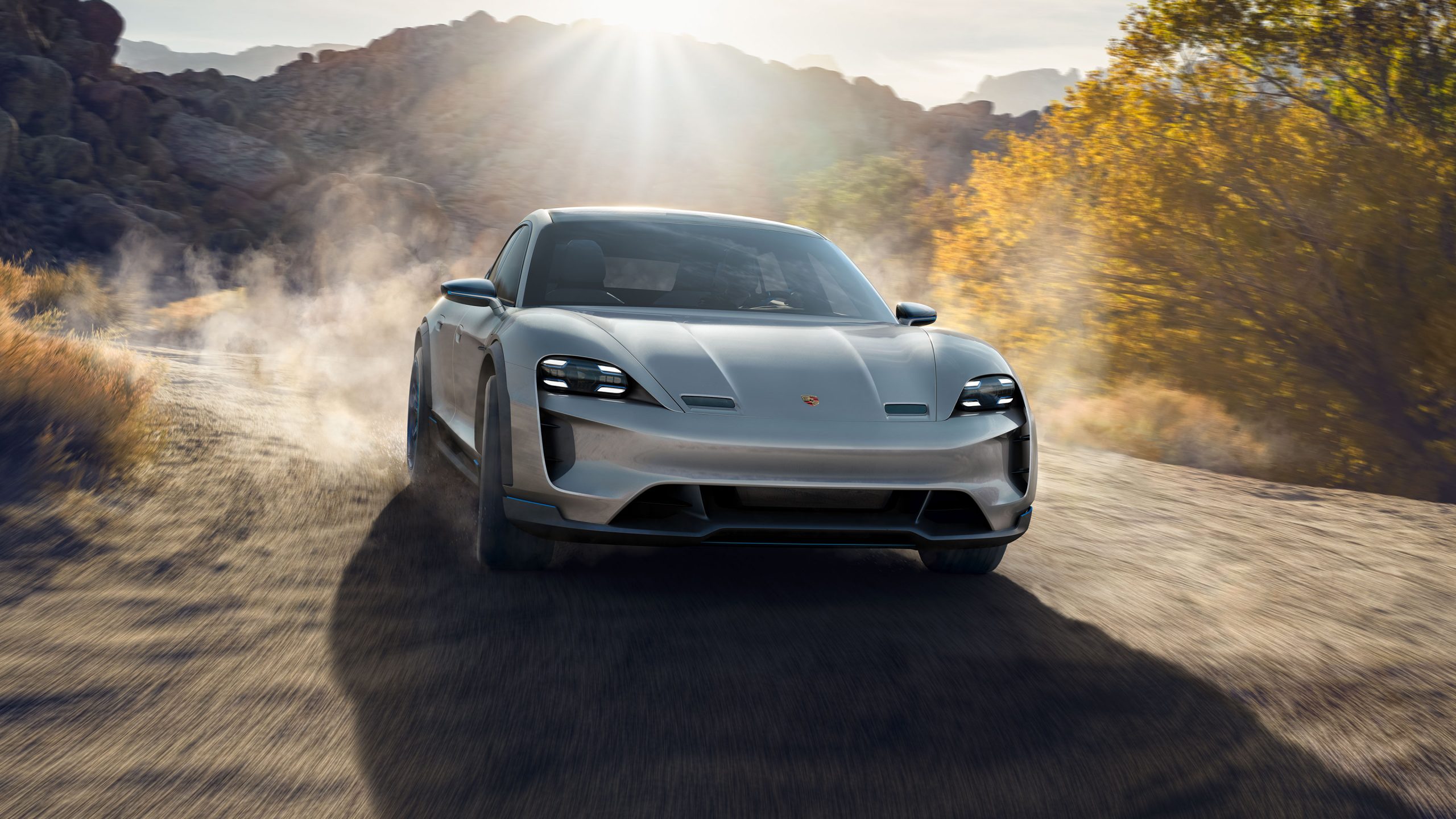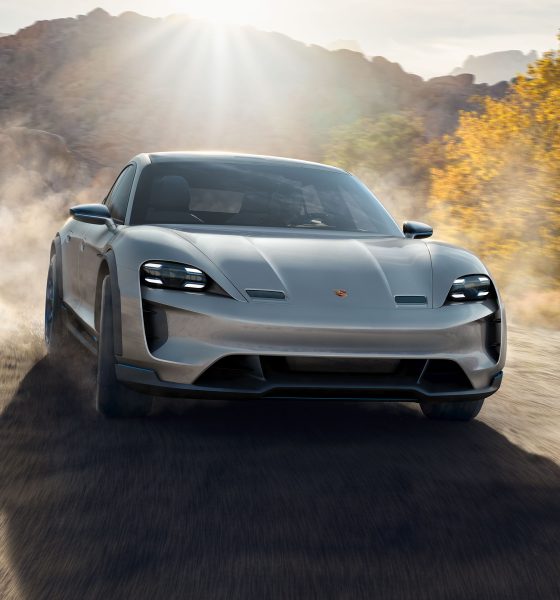

News
First reviews of Porsche Mission E Cross Turismo are in, and they are glowing
Porsche recently offered auto reviewers a chance to experience its latest all-electric vehicle, the Mission E Cross Turismo concept, firsthand. As could be seen in the initial reactions to the vehicle’s design and performance, Porsche’s off-road-capable, shooting brake-esque variant of the original Mission E sedan would likely be a strong contender in the electric car market.
The Mission E Cross Turismo concept, just like its Tesla Model S-rivaling sedan counterpart, features a highly aerodynamic design. Featuring generous vents on the side, a shape that optimizes airflow around the vehicle, and design elements such as Model S-esque pop-up door handles, the Mission E Cross Turismo was created with form and function in mind. Sitting on treaded General Grabber AT275/40R-20 tires, the Cross Turismo concept also adopts an aggressive stance.
Reviewers of the Mission E Cross Turismo gave the electric vehicle much praise, mainly due to its performance, which is unanimously dubbed as true to the car’s badge. Car and Driver, for one, lauded the Cross Turismo for its capability to sprint from 0-62 mph in 3.5 seconds, its electric motors that generate 600 hp, and its 90 kWh battery that gives a range of 310 miles. The Mission E Cross Turismo’s compatibility with the 350 kW IONITY network, which is capable of recharging 250 miles of range in just 15 minutes, was also mentioned as a strong point for the upcoming car.
The Mission E Cross Turismo is equipped with several fancy bells and whistles as well, including a drone that can take aerial videos of the electric car in action. Considering that the Mission E Cross Turismo is designed to be a vehicle that can perform equally well on and off-road, reviewers of the electric car lauded its adaptive air-spring suspension, which allows the car to raise or lower its ride height as necessary.
Inside the car itself, reviewers took particular notice to the vehicle’s rather sparse but classy interior, from its generous binnacle in front of the steering wheel to its touch panel on the passenger side. Though not as radically minimalistic as the Tesla Model 3, the Cross Turismo concept’s dashboard was found to be a departure from Porsche’s tendency to place a generous number of knobs and switches in its vehicles.
CNET Roadshow‘s Tim Stevens, one the reviewers who was given the opportunity to drive the Cross Turismo concept, ultimately stated that considering its design, features, and driving performance, the upcoming vehicle could very well make a significant impact in the electric car industry.
“The global electric car market is still quite young, and while companies like Tesla have done a great job building the stage, I can’t help but think that when the Mission E hits the market next year, it’s gonna steal the show.”
Ultimately, the Porsche Mission E Cross Turismo looks like a solid contender in the electric car market. When it starts production early next decade, vehicles such as the Tesla Model Y would likely find some competition from the electric off-roader. Porsche’s all-electric line stands to make an impact as early as next year, however, as the Mission E sedan is set to start production in 2019, followed by the Cross Turismo in 2020. Pricing for the Mission E sedan and the Cross Turismo have not been revealed by the German carmaker, though expectations are high that the latter’s cost would be in the same ballpark as the Panamera S E-Hybrid.
As Porche prepares to launch its first all-electric vehicle, the German legacy automaker is starting to increase its marketing efforts for the upcoming car. Just recently, a Mission E prototype was driven around the track by former Formula One driver Mark Webber, who noted that the sedan had similarities as the Porsche 919 Hybrid, a high-performance vehicle he drove for the company in competitions such as the 24 Hours of Le Mans.
The Mission E sedan’s concept version, which debuted at the 2015 Frankfurt Motor Show, was also taken for a spin by Maroon 5 frontman Adam Levine in a recent ad for the vehicle. In the United States, Porsche Cars North America has revealed that that it is building a network of 500 fast chargers to support the Mission E sedan’s rollout next year.
Watch Tim Stevens of CNET Roadshow take the Mission E for a test drive in the video below.

Elon Musk
Elon Musk’s X will start using a Tesla-like software update strategy
The initiative seems designed to accelerate updates to the social media platform, while maintaining maximum transparency.

Elon Musk’s social media platform X will adopt a Tesla-esque approach to software updates for its algorithm.
The initiative seems designed to accelerate updates to the social media platform, while maintaining maximum transparency.
X’s updates to its updates
As per Musk in a post on X, the social media company will be making a new algorithm to determine what organic and advertising posts are recommended to users. These updates would then be repeated every four weeks.
“We will make the new 𝕏 algorithm, including all code used to determine what organic and advertising posts are recommended to users, open source in 7 days. This will be repeated every 4 weeks, with comprehensive developer notes, to help you understand what changed,” Musk wrote in his post.
The initiative somewhat mirrors Tesla’s over-the-air update model, where vehicle software is regularly refined and pushed to users with detailed release notes. This should allow users to better understand the details of X’s every update and foster a healthy feedback loop for the social media platform.
xAI and X
X, formerly Twitter, has been acquired by Elon Musk’s artificial intelligence startup, xAI last year. Since then, xAI has seen a rapid rise in valuation. Following the company’s the company’s upsized $20 billion Series E funding round, estimates now suggest that xAI is worth tens about $230 to $235 billion. That’s several times larger than Tesla when Elon Musk received his controversial 2018 CEO Performance Award.
As per xAI, the Series E funding round attracted a diverse group of investors, including Valor Equity Partners, Stepstone Group, Fidelity Management & Research Company, Qatar Investment Authority, MGX, and Baron Capital Group, among others. Strategic partners NVIDIA and Cisco Investments also continued support for building the world’s largest GPU clusters.
News
Tesla FSD Supervised wins MotorTrend’s Best Driver Assistance Award
The decision marks a notable reversal for the publication from prior years, with judges citing major real-world improvements that pushed Tesla’s latest FSD software ahead of every competing ADAS system.

Tesla’s Full Self-Driving (Supervised) system has been named the best driver-assistance technology on the market, earning top honors at the 2026 MotorTrend Best Tech Awards.
The decision marks a notable reversal for the publication from prior years, with judges citing major real-world improvements that pushed Tesla’s latest FSD software ahead of every competing ADAS system. And it wasn’t even close.
MotorTrend reverses course
MotorTrend awarded Tesla FSD (Supervised) its 2026 Best Tech Driver Assistance title after extensive testing of the latest v14 software. The publication acknowledged that it had previously criticized earlier versions of FSD for erratic behavior and near-miss incidents, ultimately favoring rivals such as GM’s Super Cruise in earlier evaluations.
According to MotorTrend, the newest iteration of FSD resolved many of those shortcomings. Testers said v14 showed far smoother behavior in complex urban scenarios, including unprotected left turns, traffic circles, emergency vehicles, and dense city streets. While the system still requires constant driver supervision, judges concluded that no other advanced driver-assistance system currently matches its breadth of capability.
Unlike rival systems that rely on combinations of cameras, radar, lidar, and mapped highways, Tesla’s FSD operates using a camera-only approach and is capable of driving on city streets, rural roads, and freeways. MotorTrend stated that pure utility, the ability to handle nearly all road types, ultimately separated FSD from competitors like Ford BlueCruise, GM Super Cruise, and BMW’s Highway Assistant.
High cost and high capability
MotorTrend also addressed FSD’s pricing, which remains significantly higher than rival systems. Tesla currently charges $8,000 for a one-time purchase or $99 per month for a subscription, compared with far lower upfront and subscription costs from other automakers. The publication noted that the premium is justified given FSD’s unmatched scope and continuous software evolution.
Safety remained a central focus of the evaluation. While testers reported collision-free operation over thousands of miles, they noted ongoing concerns around FSD’s configurable driving modes, including options that allow aggressive driving and speeds beyond posted limits. MotorTrend emphasized that, like all Level 2 systems, FSD still depends on a fully attentive human driver at all times.
Despite those caveats, the publication concluded that Tesla’s rapid software progress fundamentally reshaped the competitive landscape. For drivers seeking the most capable hands-on driver-assistance system available today, MotorTrend concluded Tesla FSD (Supervised) now stands alone at the top.
News
Elon Musk’s Grokipedia surges to 5.6M articles, almost 79% of English Wikipedia
The explosive growth marks a major milestone for the AI-powered online encyclopedia, which was launched by Elon Musk’s xAI just months ago.

Elon Musk’s Grokipedia has grown to an impressive 5,615,201 articles as of today, closing in on 79% of the English Wikipedia’s current total of 7,119,376 articles.
The explosive growth marks a major milestone for the AI-powered online encyclopedia, which was launched by Elon Musk’s xAI just months ago. Needless to say, it would only be a matter of time before Grokipedia exceeds English Wikipedia in sheer volume.
Grokipedia’s rapid growth
xAI’s vision for Grokipedia emphasizes neutrality, while Grok’s reasoning capabilities allow for fast drafting and fact-checking. When Elon Musk announced the initiative in late September 2025, he noted that Grokipedia would be an improvement to Wikipedia because it would be designed to avoid bias.
At the time, Musk noted that Grokipedia “is a necessary step towards the xAI goal of understanding the Universe.”
Grokipedia was launched in late October, and while xAI was careful to list it only as Version 0.1 at the time, the online encyclopedia immediately earned praise. Wikipedia co-founder Larry Sanger highlighted the project’s innovative approach, noting how it leverages AI to fill knowledge gaps and enable rapid updates. Netizens also observed how Grokipedia tends to present articles in a more objective manner compared to Wikipedia, which is edited by humans.
Elon Musk’s ambitious plans
With 5,615,201 total articles, Grokipedia has now grown to almost 79% of English Wikipedia’s article base. This is incredibly quick, though Grokipedia remains text-only for now. xAI, for its part, has now updated the online encyclopedia’s iteration to v0.2.
Elon Musk has shared bold ideas for Grokipedia, including sending a record of the entire knowledge base to space as part of xAI’s mission to preserve and expand human understanding. At some point, Musk stated that Grokipedia will be renamed to Encyclopedia Galactica, and it will be sent to the cosmos.
“When Grokipedia is good enough (long way to go), we will change the name to Encyclopedia Galactica. It will be an open source distillation of all knowledge, including audio, images and video. Join xAI to help build the sci-fi version of the Library of Alexandria!” Musk wrote, adding in a later post that “Copies will be etched in stone and sent to the Moon, Mars and beyond. This time, it will not be lost.”









